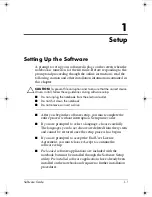
2–2
Software Guide
Power
Understanding Standby and
Hibernation
Standby and Hibernation are energy-saving features that conserve
power and reduce startup time. They can be initiated by you or
by the system. Refer in this chapter to the
“Initiating Standby,
Hibernation, or Shutdown,”
section for details about when to use
each setting.
Standby
Standby reduces power to system components that are not in use.
When Standby is initiated, your work is saved in random access
memory (RAM) and the screen is cleared. When you resume
from Standby, your work returns to the screen where you left off.
■
Saving your work before initiating Standby is not usually
necessary, but is a recommended precaution.
■
When the notebook is in Standby, the power/Standby light
flashes.
Ä
CAUTION:
To avoid a complete battery discharge, do not leave your
notebook in Standby for extended periods. Connect the notebook to an
external power source.
Hibernation
Hibernation saves your work to a Hibernation file on the hard
drive, then shuts down the notebook. When you resume from
Hibernation, your work returns to the screen where you left off. If
a power-on password has been set, the password must be entered
to resume from Hibernation.
You can disable Hibernation. However, if Hibernation is disabled,
and the system reaches a low-battery condition, the system will
not automatically save your work while power is on or Standby
has been initiated.
333634-001.book Page 2 Friday, July 18, 2003 8:47 AM















































